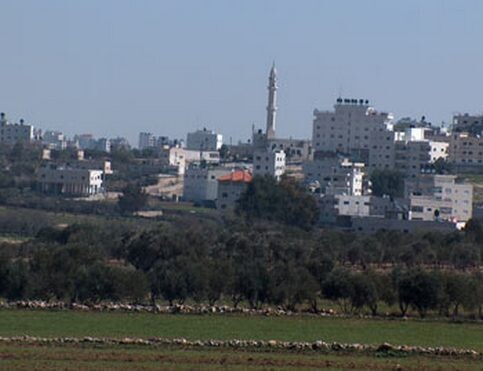B'Tselem 26 November 2006

The village of Al-Jib, 1 March 2006. (Kareem Jubran/B’Tselem)
The High Court approved the plan to run a barrier around five Palestinian villages northwest of Jerusalem , and imprison them in an enclave that will separate them from East Jerusalem and neighboring Palestinian villages. The five villages in the enclave are Beit Hanina al-Balad (1,400 residents), Bir Nabala (6,100), al-Jib (4,600), al-Judeira (2,100), and Qalandiya (1,200), which have a total population of more than 15,000 persons (hereafter: the Bir Nabala enclave).
9 high court justices approved the route of the barrier in the area, and ruled that imprisoning the villages in an enclave does not cause disproportionate harm to their residents. Completion of the barrier along the planned route facilitates de-facto annexation of settlements, and will seriously harm their fabric of life of residents of the five Palestinian communities.
Background
The route of the separation barrier in this area runs next to the three main roads that border the enclave, and will prevent residents of the enclave from using them. Thus, these roads will be “For Israeli Use Only.” The roads are Route 45 North, Route 436 West, and Route 404 (Begin North)East. In the section southwest of the enclave, the route runs along the boundary of the planned Nebi Samuel Metropolitan Park , which will serve residents of Jerusalem and nearby settlements. The planning scheme for the park has already been approved.
To prevent the complete isolation of the enclave, Israel announced that it intended to build two alternate roads that will link the enclave to the rest of the West Bank . One will connect the enclave with Ramallah, which lies to its north, and run under Route 45. The other road will connect al-Jib to Bido, which lies to its west, by means of three underground passageways and two bridges. Construction of this road will require complex engineering work and will cost tens of millions of shekels, so it is likely that the project will take a long time to complete, if it is indeed completed.
Even assuming that these two roads are built, construction of the barrier around the Bir Nabala enclave will severely impair the human rights of its residents. The main reason is that the barrier will separate them from East Jerusalem , on which the residents have always been dependent in all aspects of their lives. Thousands of the enclave’s residents hold Israeli identity cards and are entitled by law to free access to the city. In place of the connection with Jerusalem , Israel plans to force on the residents an artificial connection with Ramallah.
Especially great injury will be caused to residents of Beit Hanina al-Balad, which will be divided, leaving one part, referred to as New Beit Hanina, inside Jerusalem ‘s municipal boundaries. Many families are split, some members living in one part of the community and some living in the other part. The school system will also suffer greatly: the village’s school for boys is located in New Beit Hanina, while the school for girls is situated n Beit Hanina al-Balad. When the intifada began, Israel already blocked the 1.5 kilometer roadway joining the two parts of the village, which required the residents to travel via Bir Nabala, a distance of 7.5 kilometers. After the enclave is created, the residents will have to travel 14 kilometers and cross the Qalandiya checkpoint to get to the other side of the village. As a result of the army’s harsh bans and orders, both existing and anticipated, hundreds of residents have left Beit Hanina al-Balad.
Bir Nabala, the largest village in the enclave, currently has some 350 factories, workshops, and businesses involved in a wide range of commercial activity. The goods and services produced in the village are consumed in large part by residents of East Jerusalem , a-Ram, and villages west of Bir Nabala (Bido, Beit Sourik, and others). This extensive economic activity will suffer greatly when the village is imprisoned inside the enclave. In addition, the village’s school system relies heavily on teachers and students from East Jerusalem and nearby villages.
Residents of the five villages in the Bir Nabala enclave rely on the hospitals in East Jerusalem for medical care and treatment. Once the barrier is built around the enclave, the residents will have to make a long and tiring journey, crossing the Qalandiya checkpoint on the way, to get to these hospitals. Ramallah has one public hospital, which is barely able to provide care and treatment to the hundreds of thousands of residents in the area.
Another major problem facing all the villages in the enclave, which will likely worsen once the barrier is completed, relates to access to farmland. Residents of al-Jib, for example, own some 500 dunams of almond and olive roves outside the enclave. Although Israel has announced it would build two agricultural gates to ensure access to this land, past experience with agricultural gates has shown that the farmer’s dependence on the gates severely limits the farmers’ ability to work their land, and that some farmers are not issued permits to allow them to pass through the gates to get to their land.
Related Links